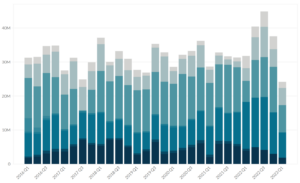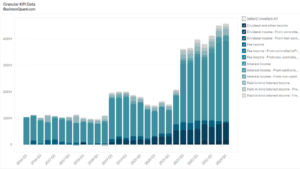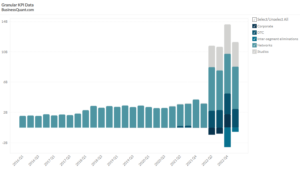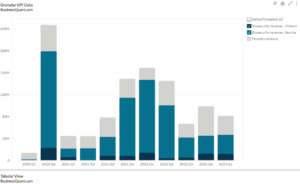
American Express’ Assets by Business Vertical (2018 – 2022)
Exclusive Data
You need the Pro Plan to access KPI data
- Full access to the platform
- KPI data & segment financials on US stocks
- Financial data on thousands of stocks
- Download data in xlsx and csv formats
Pro Plan
$49 per month*
60% discount ends in:
.
About
More information
Subscribe to Pro or Enterprise plans to unlock this feature.
Contact the Analyst
Subscribe to Pro or Enterprise plans to unlock this feature.
Become a smarter investor today.
Access KPIs & Segment Financials on US stocks
This statistic highlights American Express’ Assets by Business Vertical, split across GCS, GCSG and GMNS, reported on an annual basis from 2018 onwards.
American Express’ Assets by Business Vertical
| Vertical | 2018 | 2019 | 2020 | Contribution in 2020 |
| Global Commercial Services | $51 | $53 | $42 | 29% |
| Global Consumer Services Group | $102 | $106 | $87 | 61% |
| Global Merchant and Network Services | $16 | $18 | $14 | 10% |
| Total | $169 | $177 | $143 | 100% |
(All figures are in billions, except percentage)
The following is a quick summary of the company’s three reportable operational segments’ principal business activities:
- Global Consumer Services Group (GCSG) offers a broad variety of proprietary consumer cards across the globe. GCSG also oversees some foreign joint ventures and our partnership agreements in China, as well as providing travel and leisure services and non-card financing solutions to consumers.
- Global Commercial Services (GCS) specializes in producing a wide selection of custom corporate and small business cards. GCS also offers payment, cost management, and commercial finance solutions.
- Global Merchant and Network Services (GMNS) uses their worldwide integrated network in managing a global payments network that processes and settles card transactions, recruits merchants, and provides multi-channel marketing programs, capabilities, services, and data analytics. GMNS is responsible for managing our partnerships with third-party card issuers, merchant acquirers, and a prepaid reloadable and gift card program manager, as well as licensing the American Express brand and expanding the worldwide network’s reach. The loyalty coalition firms are also managed by GMNS.
GCS and GMNS activities are the most likely to meet institutional credit risk. This has resulted in lower results for all operations in 2020 when compared to prior years. Unlike individual credit risk, institutional credit risk has a lower frequency of losses but a higher severity. It is impacted by both macroeconomic factors and specific consumer occurrences.
The company’s principal income source is a transfer pricing method, which is used to divide discount revenue and some other revenues among segments. In the GCSG and GCS segments, discount revenue reflects the issuer component of total discount income generated by Card Members; in the GMNS segment, discount revenue reflects the network and acquirer component of overall discount revenue.
Trend
In the 2020 annual report, that the company had stated to focus on four strategic initiatives over the previous year: expanding its leadership in the premium consumer space, continuing to grow its commercial payments segment, improving its global integrated network, and focusing on its digital offerings. These objectives are expected to be developed further in the future by the firm. Since announcing a drop in merchant fees in March 2018, the company has hinted that it may be rethinking its business strategy in order to maintain rates low across the board in order to increase total transaction volume.
Key Challenges and Rivals
Despite its achievements, American Express is still lagging behind its major competitors, Visa and Mastercard, as of 2020. Although the company has decreased its merchant fees, they are still higher than those charged by certain other credit card providers, which might be a barrier to wider merchant acceptance. American Express, on the other hand, offers several advantages: It can provide a more streamlined, reliable service as both an issuer and a network than Visa or Mastercard, who don’t normally issue their own cards.
About the company
American Express is a worldwide payments corporation that connects people to products, information, and experiences that improve their lives and help them succeed in business. We are a global leader in offering credit and charge cards to individuals, small businesses, medium-sized organizations, and major corporations. Card Members can use American Express cards issued by American Express, as well as third-party banks and other institutions on the American Express network, to pay for products and services at the millions of businesses worldwide that accept our brand. The firm began as a joint stock partnership in 1850 and was organized as a New York corporation in 1965.
Did you like American Express’ Assets by Business Vertical statistic?
Access more such KPI data points and segment financials on thousands of US stocks, with Business Quant.
You can get started here.
More data on US Stocks

Our Plans
Always know what you’ll pay. No hidden costs or surprises.
- Annual
- Monthly
60% discount till April 30
Pro
For serious investing
-
Company KPI data Access segment financials, non-GAAP metrics and KPI data from presentations and filings. Examples include financials by segment / region / product category, AT&T's broadband subscriber trends, Tesla's deliveries by model and lots more.
-
Stock research tools Features include : stock screener, stock comparison, industry financials, stock warnings, advanced charting tools, timeseries tables, scatter charts, financial statements, stock reports, SEC filings, stock ratings, institutional and insider ownership data. There are 200+ financial items and ratios on thousands of US stocks.
-
Industry data & tools Access premium operating data on 40+ industries. Examples include market share, smartphone shipments by vendor, subscribers by wireless carrier, historical gold production. There are 20,000+ such statistics.
Enterprise
For tailored workflows
-
All of Pro plan Get unfettered access to all our dashboards and dossiers.
-
Custom built features Get tailored dashboards built specially for you , based on your set of requirements, to simplify your research workflow.
-
Admin billing Back-end documentation support and multi-seat licensing.
* Billed annually, local taxes extra.
60% discount on Annual plan
Pro
For serious investing
-
Company KPI data Access segment financials, non-GAAP metrics and KPI data from presentations and filings. Examples include financials by segment / region / product category, AT&T's broadband subscriber trends, Tesla's deliveries by model and lots more.
-
Stock research tools Features include : stock screener, stock comparison, industry financials, stock warnings, advanced charting tools, timeseries tables, scatter charts, financial statements, stock reports, SEC filings, stock ratings, institutional and insider ownership data. There are 200+ financial items and ratios on thousands of US stocks.
-
Industry data & tools Access premium operating data on 40+ industries. Examples include market share, smartphone shipments by vendor, subscribers by wireless carrier, historical gold production. There are 20,000+ such statistics.
Enterprise
For tailored workflows
-
All of Pro plan Get unfettered access to all our features.
-
Custom built features Get tailored dashboards built specially for you , based on your set of requirements, to simplify your research workflow.
-
Admin billing Back-end documentation support and multi-seat licensing.
* Local taxes extra.






